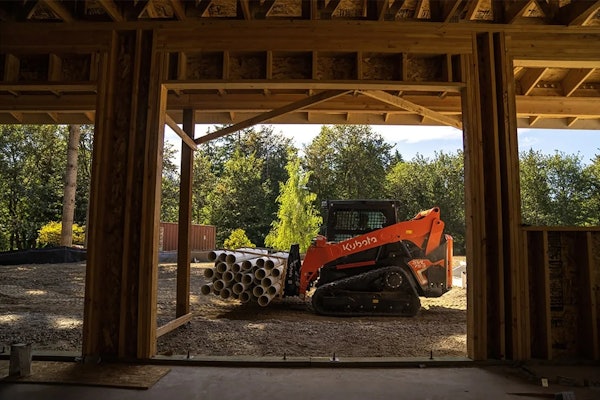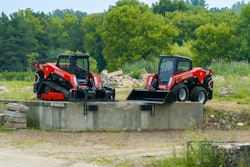Brad Fine, director of marketing for Thompson Pumps, says you need to take several pieces of information with you when you go to the pump dealer or rental store. These include your estimate of the average and peak flow requirements of your job and how fast fluid is flowing back into the trench, excavation, pond, etc. You need to know what type of fluid you’ll be pumping. If the water contains chemicals, salt, sand or fuel the pump you rent or buy will need to be made out of special materials. Know how close you will be able to place the pump to the fluid you’re pumping and how far the fluid will be pumped on the discharge end. Also estimate the size of the solids in the fluid.
Peter Snow, manager of training for Godwin Pumps of America, promotes using a pump specialist who can design a pumping system to meet the needs of your application. “Using pumps is something contractors traditionally fear because they just don’t know enough about sizing pumps for applications to make an accurate choice of equipment,” Snow says.
You can find pump rental houses or specialized pumping contractors in just about every major metropolitan area in the United States, Fine says.
Achieving full pump potential
Once you have the correct pump for the job, there are some things you can do to make sure it performs to its potential.
Centrifugal pumps should sit as level as possible. If the suction side is tilted downward, the pump may not prime. And if the discharge side of the pump is tilted down, the prime water might drain away.
If a pump is off for a prolonged period, all or some of the original prime water may drain from it. The more water you have in the pump housing, the faster it will prime.
Use the shortest suction hose possible and locate the pump as close as possible to the fluid you’re pumping. The shorter the distance a pump has to move liquid, the more volume it will deliver. Longer hoses create more friction, lessening volume. “The pump always performs best when it’s very close to the fluid being pumped,” says Mark Conrardy, sales engineering manager for Wacker. “It takes a lot of the engine horsepower away to create suction and get water moving in a hose that’s very long. A good rule of thumb is just be as close as you possibly can, even if you have to put the pump on a skid.”
When you use an engine-driven pump at elevations above sea level, the pump’s maximum suction lift will decrease and the horsepower output of the engine will be reduced. Engine power will decrease 3.5 percent for each 1,000 feet above sea level. See the chart on page 76 to find out how altitude will affect your pump’s maximum suction lift.
Suction screen placement is important, Snow says. If the screen is too low, sand or grit may be pumped, causing premature wear on the impeller and wear plates. To keep the suction strainer out of bottom mud while pumping from a large body of water such as a lake, Conrardy suggests securely tying the suction hose to something that floats – an inner tube or foam block, for instance – so the strainer stays up but rides with the water level. Be aware, however, that if the suction strainer is too close to the surface, vortexing may occur, reducing the amount of fluid being pumped, Snow cautions.
Guard against common mistakes
Never operate a pump unless the factory-recommended strainer for that pump is on the suction hose. The pump is likely to ingest an object larger than it is made to handle and the pump will get clogged, if not seriously damaged.
Always drain water from your pump after each use, especially in colder climates. In freezing temperatures, the water left inside the pump will turn to ice and the pump casing will probably crack.
More is not always better with trash pumps, Snow says. If you are using a surface-mounted trash pump with a relatively short, horizontal discharge run, there is little total resistance and the pump will pump maximum flows at fairly low revolutions per minute. “Because ‘more is better,’ however, many pump operators will maximize the pump’s speed to ‘pump more water,'” Snow says. “The unfortunate result is increased wear and tear on both the pump and the engine.”
Using a pump that’s too large or too small for the task at hand can cut down on productivity or damage the pump. Using too small of a pump is a waste of man hours, says Steven Spence, product manager for Multiquip, especially if someone is waiting until the water is pumped out to do something.
If the pump is too large for the amount of water to be pumped, the equipment is being used inefficiently. “When you have several hundred gallons of water to pump out, using a 6-inch pump to do it is not a very smart idea,” Spence says. “You’re using a big piece of equipment to do a very small job.” And if no one is monitoring the pump and it runs out of water, the possibility of seal damage is great if you are using a centrifugal pump.
One of the most common mistakes contractors make is using a pump made for pumping water-based fluids to pump chemicals, fertilizers, salt water or fuel, Spence says. If you are pumping chemicals, you need to make sure those particular chemicals won’t react with the materials that make up the pump’s outer casing, impeller and volute. A lot of pumps are made out of aluminum, which reacts quickly to many chemicals. If you use an aluminum pump, for example, to pump sea water exclusively, you will only get 25 percent of the life of the casing. If you need to pump fuels or oils, you should use a pump specially designed for that application.
“Water hammer” can also damage your pump. This occurs when a discharge hose is running alongside a road and a vehicle runs over it as the pump is operating. “That instantaneous shutoff of the water will create a shock effect going back to the pump and it can crack and damage the pump casing itself, or the pump housing,” Spence says. To prevent water hammer, place small boards on either side of the discharge hose.
Using a hose that’s too small for your pump can cut down on production, Conrardy says. For example, an operator might have a 3-inch pump and only 2-inch hose. Using a hose that’s too small for your pump will add a much higher rate of friction and prevent water from moving through the lines the way it should.
Jeff Davis, national sales manager for contractor and dewatering pumps for Pumpex, says operators often install electric submersible pumps so they are running backward, causing the impeller and seals to wear out prematurely. A start/reaction arrow on the pump should indicate the correct direction or that information can be found in the pump’s manual. The pump will work at peak performance only when the impeller is turning in the proper direction, Davis says.
Putting a working submersible pump directly on a soft, mucky or sandy surface is not a good idea. “You need to keep the pump at least a few inches off the ground so it doesn’t clog itself up or pump pure sand,” Davis says. “It can handle solids, but it can’t handle 100 percent of them.” He recommends sitting the pump on a wooden pallet.
Another common mistake people make when using submersible pumps is pulling them out of the water by the cable. If you pull even small pumps out of the water by their cable, the cable will come loose from the seal and water will get in the pump, shorting it out. Running over the cable with other equipment can also damage it and create an opening for water to get inside the system. “Whenever you’re going to remove or install an electric submersible pump, physically inspect the power cable for any slices or holes,” Davis advises.
And don’t let the open end of the cable fall in the water. The cable absorbs water that can short out the pump when someone hooks it up.
Trouble shooting
If a pump known to be operational suddenly won’t prime, the first place to look is the suction hose, Conrardy says. The problem is likely in the fitting attaching the hose to the pump – a missing gasket or air getting in where the male bayonet enters the hose. A puncture in the hose itself could also be the culprit. If so, you can pack mud around the hole or use duct tape as a temporary fix.
Often hoses get damaged during transport or rubber gaskets fall off and are lost. “Something as simple as just having extra gaskets even attached to the pump itself with a piece of wire can save the day,” Conrardy says.
If suction or discharge cavitation occurs, the impeller and wear plate of your pump will probably sustain damage. If suction cavitation is occurring, the suction lift might be too high for the application. If that’s not the problem, the suction hose might have a partial or total obstruction or the diameter of the suction hose could be too small. If discharge cavitation is taking place, the discharge head, or pressure, is too high.
If the pump is performing below par, debris that should not enter the pump but can flow through the strainer – such as fibers, rags, sticks or leaves – may be clogging the machine. Open the pump and clean it out.
Maintain engine, internal parts
If you have an engine-driven trash pump, the engine should be maintained as it would be in any other piece of equipment. Check and clean air filters and change oil per the manufacturer’s recommendations. If you have a centrifugal pump, you have to monitor the distance between the impeller and the wear plate. As the two surfaces wear, the gap between them gets bigger, lessening the pump’s efficiency. If there are complaints about the pump’s performance, you should check the distance between the impeller and wear plate. Even if you don’t have complaints, a good rule is to check the gap when you change the engine oil, Conrardy says. If the gap is too large, you can correct it by placing shims behind the impeller or wear plate.
If the engine is not running at the correct rpm, it will have an exponential affect on pump flow. When the pump is serviced between uses you should check the rpm with an electronic tachometer, Spence says. Also make sure the pump casing is clear of debris and if the pump has been used in salt water, flush it with fresh water to minimize corrosion.
Electric submersible pumps are reasonably self contained, but require periodic scheduled maintenance to prevent major failure, Davis says. You should check the oil every time the pump comes out of the field to see whether the seals are holding or leaking water. If there is water in the oil chamber, the seal is probably leaking and eventually pressure will build up in the chamber and blow oil and water into the motor.
As mentioned before, check the power cable for any holes or tears before and after each use. Davis recommends making one person responsible for inspecting all power cables when they are brought in from jobs. Pumps should then be tagged “ready to be issued” so someone doesn’t take a pump that hasn’t been inspected back to the jobsite.
Godwin Pumps’ Snow says the best way to prolong the life of a pump is to use it only in situations it is designed to handle. “Pumps are like shoes,” he says. “One size does not fit all.”








